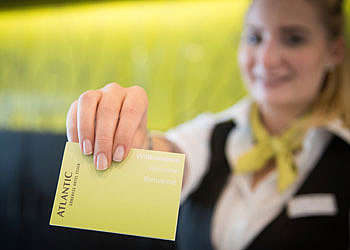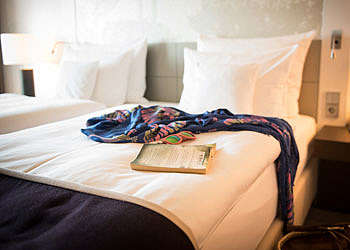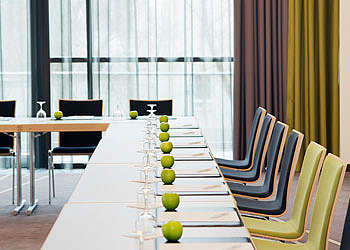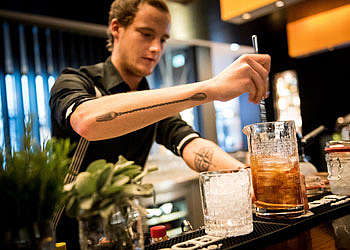On the trail of the Krupp family dynasty.
During your stay in the Ruhr Metropolis, don’t pass up the opportunity to follow the trail of the Krupp family. Hardly any other family shaped Essen and the Ruhr Region as much as this industrial family dynasty in the 19th and 20th centuries. They built what has sometimes been Europe’s largest company: Friedrich Krupp AG, headquartered in Essen. Today it’s better known as thyssenkrupp AG, which the company has been called since its merger with Thyssen AG in 1999.
Gartenstadt Margarethenhöhe
You probably don’t think of Essen as a garden city. So a visit to the Margarethenhöhe will be all the more surprising: The 115-hectare settlement, wonderful to see during the summer, was endowed in 1906 by Margarethe Krupp on the occasion of the wedding of her daughter Bertha. While it was being built from 1906 to 1938, it was exempted from all construction regulations by a government decree—a distinction shared only with the garden city of Dresden-Hellerau. It served as a residential area not only for employees of the Krupp company, but also for Essen city officials. From the beginning of its construction, the Margarethenhöhe was one of the most important garden suburbs in Europe. During Europe’s garden city movement, it represented almost 3 decades of construction work in which the well-established was constantly refined and the new was attempted. Along with the Siepentälern, which surround the garden suburb and have been redesigned into wooded parks, the Margarethenhöhe offers a quality of life seldom achieved by urban development to this day. Its houses are all different from one another and still have a strong attraction—and not only for architecture enthusiasts. The charming overall impression is marked by arched gables, arcades, bay windows, wooden shutters and natural stone plinths. For a look behind the scenes, the Margarethenhöhe has a show flat erected by the Ruhr Museum and the Margarethe Krupp Foundation. It can be viewed as part of a tour. It shows the carefully coordinated details of the construction and furnishing by using a few original Metzendorf furniture pieces and accurate replicas.
The thyssenkrupp quarter.
thyssenkrupp AG’s current corporate headquarters stands in total contrast. After a construction time of three years, the 300-million-euro site was opened in a celebration in June 2010, located on the exact spot on which Krupp has its roots with the cast steel factory in Essen. One of the area’s highlights is the main building Q1. Transparent thanks to its glass facade, it resembles a gate and towers over 14 storeys. With a height of 50 metres and a distinctive, expressive form, it is a true eyecatcher for every visitor. And technically speaking, it’s unchartered territory—the glass wall is neither standing nor hanging, but stretched vertically and horizontally like a tennis racket. The 25.6 x 28.1 metre glass facades are divided into 96 white panes of glass, and can give up to half a metre when impacted by the wind. But the exterior area is also worthy of notice: Around 700 trees have been planted, and numerous green areas created. And in front of the Q1 is a water axis, 200 metres long and 30 metres high, which is traversed by a number of connecting paths between the individual buildings.
When you visit the premises you’re sure to notice something else: a small, slated, half-timbered building. This is Krupp’s original company building, first constructed as an overseer’s cottage for the factory in 1818–19 and later becoming the residence of the Krupp family. It was destroyed in the war, and faithfully reconstructed in 1961. Today it stands on its original location, next to the impressive residential area. The interior was reconstructed according to old photos and plans: Carpets and curtains were replicated, (non-functioning) power lines were laid on the plaster once more, and original lamps were hung. And in the office is a writing desk once actually used by Friedrich Alfred Krupp.
Villa Hügel
A trip into the past leads to a visit of one of the area’s most significant attractions: the Villa Hügel. Built by Alfred Krupp in 1870–73, the Villa lies above the Baldeneysee in the associated 28-hectare Hügelpark. With 8,100 m2 of residential and usable space in 269 rooms, it was the residence and entertaining house for the industrial family Krupp. Prominent personalities, crowned heads, and artists came and went. The interior of the main house includes a gallery of paintings, while an exhibition in the “small house” tells the story of the Krupp family and how their company was developed. Today the property is owned by Alfried Krupp von Bohlen and the Halbach Foundation. The house is the home to regular events such as concerts and exhibitions. Numerous historic rooms and the historic Krupp exhibition can be viewed during regular hours. By the way: Alfred Krupp planned his family residence as an ultramodern house made of “iron and stone”, very atypical of the time. He refused to use wood from fear of fire. The Villa Hügel is officially entered into the land registry as a one-family house, making it the largest in Germany.
By the way: the Villa Hügel & the Margarethenhöhe are points at the essen city tours.






